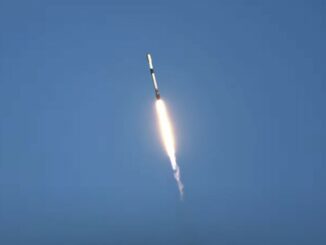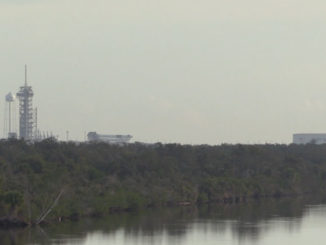
NASA announced agreements worth a combined $43.2 million with 14 commercial partners Friday — including Blue Origin and SpaceX — to fund experiments in propellant and power generation, in-space refueling, efficient propulsion systems, and lunar rover technology.
Each of the agreements, with NASA funding commitments ranging from $1.3 million to $10 million, will aid the development of key technologies for the space agency’s exploration initiatives aimed at the moon and Mars, officials said.
The 14 projects announced Friday are the fourth set of funding agreements in NASA’s series of “Tipping Point” solicitations, in which the space agency partners with companies to work on advanced space technologies. Each company is required to fund at least 25 percent of the program costs in the public-private Tipping Point agreements.
“These promising technologies are at a ‘tipping point’ in their development, meaning NASA’s investment is likely the extra push a company needs to significantly mature a capability,” said Jim Reuter, associate administrator of NASA’s space technology mission directorate. “These are important technologies necessary for sustained exploration of the Moon and Mars. As the agency focuses on landing astronauts on the Moon by 2024 with the Artemis program, we continue to prepare for the next phase of lunar exploration that feeds forward to Mars.”
Previous Tipping Point agreements have funded cryogenic propellant storage technologies, the development of planetary landing systems, solar-electric propulsion, smallsat launch vehicles, and robotic in-space manufacturing.
The agreements announced Friday address six focus areas: Cryogenic propellant production and management; sustainable energy generation, storage and distribution; efficient and affordable propulsion systems; autonomous operations; rover mobility; and advanced avionics.
Blue Origin won the biggest share of funding in Friday’s announcements with a $10 million agreement, and NASA awarded SpaceX $3 million to test coupler prototypes for refueling spacecraft such as the company’s Starship vehicle.
Two providers selected by NASA through the Commercial Lunar Payload Services, or CLPS, program also received funding from NASA through the Tipping Point solicitation. Astrobotic and Intuitive Machines are developing commercial robotic lunar landers to deliver NASA science instruments to the lunar surface.
Here is a list of the 14 agreements copied from a NASA’s press release:
Cryogenic Propellant Production and Management
• Blue Origin LLC of Kent, Washington, $10 million
A ground demonstration of hydrogen and oxygen liquefaction and storage, representing rocket and spacecraft propellant that could be produced on the Moon. The demonstration could help inform a large-scale propellant production plant suitable for the lunar surface.
• OxEon Energy LLC of North Salt Lake, Utah, $1.8 million
OxEon Energy will work with the Colorado School of Mines to integrate an electrolysis technology to process ice and separate the hydrogen and oxygen. The molecules could then be cooled to produce fuel for cislunar transport. This technology could provide a flexible and scalable solution for future in-situ resource utilization operations on the Moon.
• Skyre Inc. of East Hartford, Connecticut, $2.6 million
Skyre, also known as Sustainable Innovations, along with partner Meta Vista USA LLC, will develop a system to make propellant from permanently frozen water located at the Moon’s poles, including processes to separate the hydrogen and oxygen, keep the product extremely cold and use hydrogen as a refrigerant to liquefy oxygen.
• SpaceX of Hawthorne, California, $3 million
SpaceX will collaborate with NASA’s Marshall Space Flight Center in Huntsville, Alabama, to develop and test coupler prototypes – or nozzles – for refueling spacecraft such as the company’s Starship vehicle. A cryogenic fluid coupler for large-scale in-space propellant transfer is an important technology to aid sustained exploration efforts on the Moon and Mars.
Sustainable Energy Generation, Storage and Distribution
• Infinity Fuel Cell and Hydrogen Inc. of Windsor, Connecticut, $4 million
The company will collaborate with NASA’s Johnson Space Center in Houston to develop a scalable, modular and flexible power and energy product that utilizes new manufacturing methods to reduce cost and improve reliability. The technology could be used for lunar rovers, surface equipment and habitats.
• Paragon Space Development Corporation of Houston, $2 million
Paragon Space Development Corporation will work with Johnson and NASA’s Glenn Research Center in Cleveland to develop an environmental control and life support system as well as a thermal control system for lunar missions that maintain acceptable operating temperatures throughout the Moon’s day and night cycle. The design of these systems could be adapted for crewed missions to Mars.
• TallannQuest LLC of Sachse, Texas, $2 million
Working with NASA’s Jet Propulsion Laboratory in Pasadena, California, the company, also known as Apogee Semiconductor, will develop a flexible, radiation-hardened switching power controller capable of being configured based on a mission’s power needs. This technology could be used for missions to the Moon, Mars, Jupiter’s moon Europa, and other destinations.
Efficient and Affordable Propulsion Systems
• Accion Systems Inc. of Boston, $3.9 million
The first interplanetary CubeSats, NASA’s MarCO-A and B, used a set of cold gas thrusters for attitude control and course corrections during their cruise to Mars, alongside the Mars InSight lander. Accion and JPL will partner to mature a propulsion system to demonstrate the same capabilities as those required for the MarCO mission, but with a smaller and lighter system that uses less power. The propulsion system could enable more science opportunities with these small, flexible platforms.
• CU Aerospace LLC of Champaign, Illinois, $1.7 million
CU Aerospace, NearSpace Launch and the University of Illinois at Urbana-Champaign will build and test a 6-unit CubeSat equipped with two different propulsion systems. These systems were developed with NASA Small Business Innovation Research (SBIR) funding and offer high performance, low cost and safe pre-launch processing. The company plans to deliver the flight-ready CubeSat to NanoRacks for launch and deployment.
• ExoTerra Resource LLC of Littleton, Colorado, $2 million
ExoTerra will build, test and launch a 12-unit CubeSat with a compact, high impulse solar electric propulsion module. Once flight-ready, the system will be demonstrated in-space as the CubeSat moves from low-Earth orbit to the radiation belts surrounding Earth. This small electric propulsion system could open up the inner solar system for targeted science exploration missions, using affordable spacecraft that range from 44 to 440 pounds.
Autonomous Operations
• Blue Canyon Technologies Inc. of Boulder, Colorado, $4.9 million
As access to space increases, so does the need for ground resources, such as tracking stations. With an in-space demonstration, Blue Canyon Technologies will mature an autonomous navigation software solution for SmallSats and CubeSats so they can traverse space without “talking” to Earth.
Rover Mobility
• Astrobotic Technology of Pittsburgh, $2 million
Astrobotic and Carnegie Mellon University will work with JPL and NASA’s Kennedy Space Center in Florida to develop small rover “scouts” that can host payloads and interface with multiple large landers. This project received previous NASA funding through SBIR awards. The new partnership will develop more mature payload interfaces and increase rover capabilities.
Advanced Avionics
• Intuitive Machines LLC of Houston, $1.3 million
Development of a spacecraft vision processing computer and software to reduce the cost and schedule required for deploying optical, or laser, navigation capabilities on government and commercial missions.
• Luna Innovations of Blacksburg, Virginia, $2 million
Luna Innovations is partnering with Sierra Nevada Corporation, ILC Dover and Johnson to prove the viability of sensors that monitor the structural health and safety of inflatable space habitats located in orbit or on the surface of other worlds.



